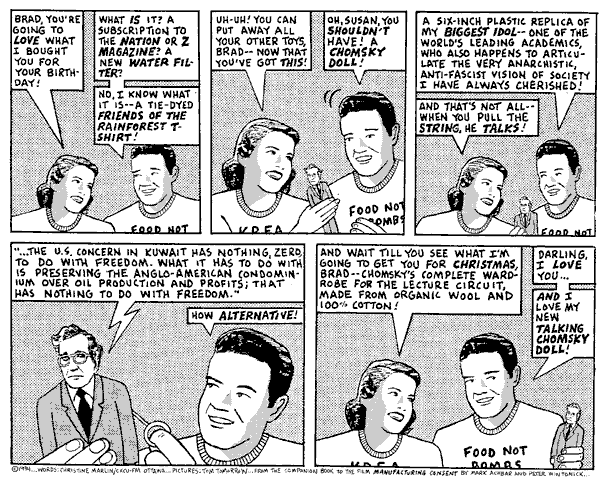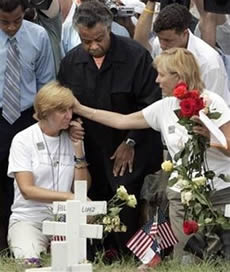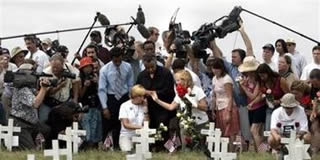Different Political Spectrums

In the US ,or more broadly the world, the political spectrum is most often represented as a simplistic line as in Left-Right Politics. I don't think this shows enough variety of political views. Now I am not sure if I can ever answer these questions of where these political philosophies fit into a political spectrum map:
Where does the Fascist fit?
Shouldn't religion be not a left-right question?
The same with environmentalists, and any particular ethnic group.
George Orwell once argued that the difficulty in classifying Left versus Right is due in part to the propensity for nascent factions of an ideology to be disavowed and labeled as being on the opposing side of the left-right divide by their erstwhile comrades - or they may so choose to label themselves to highlight their disagreement. This results in incremental or evolutionary doctrinal distinctions being placed in opposition in the popular perception of the left-right political spectrum.
My first political science instructor stated that the straight line was not sophisticated enough and he drew a circle with a small gap on the bottom. He said as politics went to the extreme left and right end up being closer to each other than the centrists. I believe that the closest were anarchists and communists. I never have run across this political theory again. Below gives a clue that even if socialist believe in government, they are suppose to migrate to a communist system with no formal government.
For a start, Communism was never a social system at all, but a political MOVEMENT. There is a social system called ‘communism’, which literally means people living in communes (barracks), with no private ownership of property, no government, and everything shared out on the principle ‘from each according to their ability, to each according to their need’.
So now that I have concluded our political spectrum can not be analyzed by a line then what other model can we think of to explain the differences in political groups. A good place to start is Political Spectrum. The first chart is Nolan Chart. I like this because it shows that Liberatarians strive for more economic and personal freedoms.

But this also places Fascist and Communist in the same lower left corner, so maybe too simplistic. But try the test anyway.
And now for something completely different...Take the test. This might be the best model but what do you think? This would be the best test if you only want to do one, but it is fairly long.
If we recognise that this is essentially an economic line it's fine, as far as it goes. We can show, for example, Stalin, Mao Tse Tung and Pol Pot, with their commitment to a totally controlled economy, on the hard left. Socialists like Mahatma Gandhi and Robert Mugabe would occupy a less extreme leftist position. Margaret Thatcher would be well over to the right, but further right still would be someone like that ultimate free marketeer, General Pinochet.
That deals with economics, but the social dimension is also important in politics. That's the one that the mere left-right scale doesn't adequately address. So we've added one, ranging in positions from extreme authoritarian to extreme libertarian.

Both an economic dimension and a social dimension are important factors for a proper political analysis. By adding the social dimension you can show that Stalin was an authoritarian leftist (ie the state is more important than the individual) and that Gandhi, believing in the supreme value of each individual, is a liberal leftist. While the former involves state-imposed arbitary collectivism in the extreme top left, on the extreme bottom left is voluntary collectivism at regional level, with no state involved. Hundreds of such anarchist communities exisited in Spain during the civil war period
You can also put Pinochet, who was prepared to sanction mass killing for the sake of the free market, on the far right as well as in a hardcore authoritarian position. On the non-socialist side you can distinguish someone like Milton Friedman, who is anti-state for fiscal rather than social reasons, from Hitler, who wanted to make the state stronger, even if he wiped out half of humanity in the process.
The chart also makes clear that, despite popular perceptions, the opposite of fascism is not communism but anarchism (ie liberal socialism), and that the opposite of communism ( i.e. an entirely state-planned economy) is neo-liberalism (i.e. extreme deregulated economy).
With some political points of views:

My results:
The Political Compass
Economic Left/Right: 7.38
Social Libertarian/Authoritarian: -0.56
Your political compass
Economic Left/Right: 7.38
Social Libertarian/Authoritarian: -1.74
{11/12/2010}
The next model is Pournelle. While I like the statism as a factor, defined as either "state as ultimate evil" and "state worship", and be sure to read this on rationalism also.

The next model is Friesian Political Spectrum. It starts with the Nolan Chart and then makes it 3d with Z axis being liberty value. How about another test? I will try to study this later.
And lastly this chart is interesting. This seems to imply that we are more likely to get along with others in our group. But some international bonds are formed when both parties are willing to spend the social and political energy to get past cultural divides. Because I see the relationship of Japan and the US to be under this mutual cooperation, even though Japan is Confucian and the US is English Speaking.

I don't expect this to explain all aspects of political landscapes but at least get a primer started on thinking of how political parties in the US and the world should be analyzed in relationship to each other. One of my philosphies is that people or to a broader sense groups should be allowed to express themselves in their own words and not imposed by outside groups that want to disparage such groups in hyperbolic political attacks.
P.S.: I know that this might be going afield but Jason from ThomHartman's blog presented another political map defined as Triangle-of-Power. The three points of his equilateral triangle is defined as Government, Corporations and People. The Government is loosely defined as "The group that has control." This could mean elected politicians or a authoritarian monarchy like a king or a professional bureaucratic class. While Karl Marx does not put much emphasis on governments, he does talk about the bourgeoisie.
Corporations (bourgeoisie) as Jason defines is entities with wealth much greater than the average person. Marx: the bourgeoisie : those who "own the means of production" and exploit the proletariat. Jason does not define "wealth much greater than the average person", so we can not easily define who would be in that group. From his piece and his post on ThomHartman's blog, Jason sees corporations or businesses in general are a neccessary evil.
People (proletariat): This group is unique, as the other two are merely sub sections of this group. The People are all those that live on the land. Strangely enough, this group holds the most natural power when they act with one voice.
Thinking back to the triangle with the three corners being the categories of power, then you can see that where the country stands would be a combination of distances from the three corners. The closer the point is to one corner the more power that group has over the nation. I see that the lines are never possible to be at since each group has at least some power influence. But it is interesting to see the point with the three lines drawn to the respective corners.
Labels: Democratic Peace

 xxx
xxx










